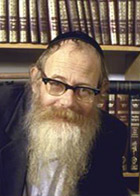Talmud for Everyone?

Later this year, a milestone in contemporary Jewish learning will be reached with the completion of the Steinsaltz translation of the Talmud from its rabbinic Hebrew-and-Aramaic original into modern Hebrew. First begun in 1965, this project has had a transforming effect on non-Orthodox Israeli culture.
The work is the brainchild of Rabbi Adin Steinsaltz. Born in 1937 to secular parents who nevertheless saw to his education in Jewish classics, he studied math, physics, chemistry, and sociology before turning to religion, publishing books on the Bible and Jewish mysticism, and creating a network of high schools offering a rare blend of Talmud, neo-Hasidism, and bohemia. But it is on his 45-volume edition of the Talmud, initiated in his late twenties, that his fame in Israel rests.
The edition offers the traditional texts, with (in a departure from standard practice) punctuation and vocalization clearly marked; Steinsaltz's Hebrew rendering alongside paraphrases of classic commentaries; capsule summaries of legal decisions emerging from the texts; and, in a nod to academic scholarship, lists of variant readings, linguistic notes, and illustrations of the material culture of ancient times. All are laid out in a contemporary Hebrew design.
In 1989, an English version of the Steinsaltz Talmud was launched, with much fanfare, by Random House. The enterprise was eventually discontinued both for monetary reasons and because of the serious competition presented by another English Talmud. This one, brought out by the ultra-Orthodox ArtScroll publishing house and known (after its funder) as the Schottenstein edition, is marked not only by friendlier typography but by a textual ambience welcoming to Orthodox as well as non-Orthodox users and, in its notes and glosses, by a fuller flavor of traditional scholarship.
Also in 1989, all of Steinsaltz's writings were placed under a religious ban by Israel's ultra-Orthodox authorities. The chief charge was that in certain of his books Steinsaltz had treated such biblical figures as the patriarchs and King David with a lack of reverence. As for his Talmud, it was censured for dispelling the work's sanctity, both in the way he presented it and by the very act of making it available to a reading public of non-Orthodox Jews.
The rabbis may have had a point. In a network of "alternative" institutions that have emerged in Israel in recent years, secular and religious Jews gather together to study classic texts as if in a traditional "beit midrash"—one, however, where discussion is conducted in a deliberately pluralistic and open-ended manner. The participants in these circles increasingly write, sing, and lecture about traditional texts out of their own understandings. While the future shape and cultural implications of this phenomenon remain unclear, none of it would have been conceivable without the Steinsaltz Talmud.
Comments are closed for this article.




